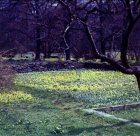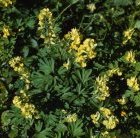 |
QUICK SEARCH
MO PROJECTS:
Africa
Asia/Pacific
Mesoamerica
North America
South America
General Taxonomy
Photo Essays
Training in Latin
America
MO RESEARCH:
Wm. L. Brown Center
Bryology
GIS
Graduate Studies
Research Experiences
for Undergraduates
Imaging Lab
Library
MBG Press
Publications
Climate Change
Catalog Fossil Plants
MO DATABASES:
W³MOST
Image Index
Rare Books
Angiosperm
Phylogeny
Res Botanica
All Databases
INFORMATION:
What's New?
People at MO
Visitor's Guide
Herbarium
Jobs & Fellowships
Symposium
Research Links
Site Map
Search
ORNAMENTAL PLANTS OF HORTICULTURE VALUESelection of perennials
A large genus of some 300 species in the temperate regions of the Northern Hemisphere, of which 70 in the FSU. There are numerous endemics, especially in Central Asia. In addition, 15 species occur in the Far East and about 10 in the Caucasus. Some species have taproot, others a tuber. C. ambigua Cham. et Schlecht.
Far East (Sakhalin, Kuril Islands, Kamchatka, in mainland coastal area near the Sea of Okhotsk), northern Japan, China and Korea. In forests, on grassy hills, along streams and on banks. A quite variable species. Tuber flattened-globose, to 1.5-3.0 cm across. Stems 2 or 3, 10-20 cm; leaves 2-4, biternate, blue-green. Flowers in loose racemes, clear blue-violet with long spur. V - early spring to mid-summer. Fl - April or May (in St. Petersburg) for 3-4 weeks. Fr - June. P - by fresh seed, can be self-sown. Does well in semishade, on a moist, well-drained soil. Well suited to the rock garden. Z 4. New. C. bracteata (Stephan) Pers.
Siberia (Altay, Sayans, Dahuria) and Mongolia. In forests, among shrubs. Rootstock tuberous, small, 8-30 mm diam. Stem up to 10-50 cm during flowering period. Flowering shoot with one large membraneous leaf and two glaucous-green, 2-ternate leaves 5-35 cm x 5-10 cm. Inflorescence cymose, flowers 2-15, yellow, with corolla 1.5-4.5 cm diam. V - April to early July. Fl - early summer (April-May in St. Petersburg), for 3-4 weeks. Fr -early June. P - by seed or by division (by daughter tubers). Self-propagating species which once established can grow for many years in the same place. Undemanding to soil and illumination but sensitive to high level of ground water, prefering well-drained soil. Z 4. New. C. buschii Nakai Far East (southern regions), Japan, China and Korea. In open woodlands, moist sites. Rhizome creeping with tubers of irregular form. Stem usually single, erect, 10-25 cm. Leaves 3-4, long-petiolate 3- or 4-ternate, blue-green. Flowers 15-25 in racemes, pink or purple. Corolla erect, 25-35 mm long, with long spur. V - early spring to mid-summer. Fl - May. Fr - June-July. P - by seed sown immediately when ripe, also very easy by division (by annual tubers, by stolons). Z 5. New. C. gigantea Trautv. et C.A. Mey. Far East (Ussuryiskiy, Zeya-Bureinskiy, Udskiy and Okhotskiy regions and Sakhalin Island), northern China and Korea. In open woodlands, in open coniferous forests, mainly in moist places. Taproot and rhizome thick, tuber-like, 60-70 cm deep, 6-10 cm diam. Stems up to 120 cm, branched, with 3 bracts near the base and 5 large green leaves. Leaf blade 2- or 3-ternate. Lobes of leaflets oblong or linear. Racemes dense or sometimes loose, 10-25 cm long, branched, with small but numerous dark pink flowers. V - early spring to mid-summer (in St. Petersburg April to July). Fl - May or June for 3-4 weeks. Fr - July. P - by seed, sown immediately when ripe, or by division of tuberous rhizomes. Requires a partly shade site. Z 4. New. C. nobilis (L.) Pers. Siberia (Altay) and Central Asia (Tarbagatay). Among shrubs, on rocky places, and in shady ravines. Stem 40-50 cm high. Taproot long and thick, often dessected at the top. Basal leaves petiolate, glaucous 3-pinnatesect, stem leaves shortly petiolate. Inflorescence short, compact, cymose. Flowers yellow or orange-yellow with dark spots. Inner petals dark violet at the top. V - early spring to mid-summer (in St. Petersburgh April to July). Fl - April to May for 2-3 weeks. Fr - June. P - by seed, sown immediately when ripe. Plants flower the second year after sowing. Copiousely self sown. Undemanding as to habitat. Good for spring decoration and for the rock garden. Z 4. The following species are also of interest to gardeners: C. angustifolia (Bieb.) DC. Southern Caucasus and Iran, naturalized in northern Russia and the Crimea. Tuber small, 7-15 mm diam., flowers in loose racemes, yellow. Z 5 (4). C. ledebouriana Kar. et Kir. Mountains of Central Asia, Iran, Afghanistan and northeastern China. Tuber 5-7 cm diam. Flowers pink or violet, very variable. Z 5 (4). New. C. paeoniifolia (Stephan) Pers. Far East and Siberia (central and eastern regions). Rhizomateous. Flowering stem 60 cm, flowers 1.5-3.5 cm long, pink-violet in long dense racemes. Z 4. New. C. pauciflora (Stephan) Pers. Far East (northern regions), Siberia (Altay, Sayans) and Mongolia. Tuber globose, small. Stem unbranched, up 20-30 cm. Flowers in dense racemes, bright blue-violet. Flowering period 3-4 weeks. Z 4. New. C. popovii Nevski ex Popov Central Asia. Tuber globose, very deep in soil. Stem solitary, 7-10 cm. Leaves 3-ternate, grey-green. Flowers 2-6 in loose racemes, pink- violet with very long spur deflexed at the apex. Requires a sunny place. Z 5. New. C. remota Fisch. ex Maxim. East Siberia and the Far East (southern regions). Related to C. ambigua Cham. et Shlecht. and to C. bulbosa (L.) DC. It differs in its toothed bracts. Inflorescence dense, flowers pink-violet. Z 4. New. C. repens Mandl et Muehld. Southern regions of the Far East. Tuber globose. Stem slender, 8-10 cm. Flowers in dense racemes, white or pink, light blue. Z 5 (4). New. |
||||
| SELECTION OF PERENNIALS |
© 1995-2025 Missouri Botanical Garden, All Rights Reserved
4344 Shaw Blvd.
St. Louis, MO 63110
(314) 577-5100
Technical Support

